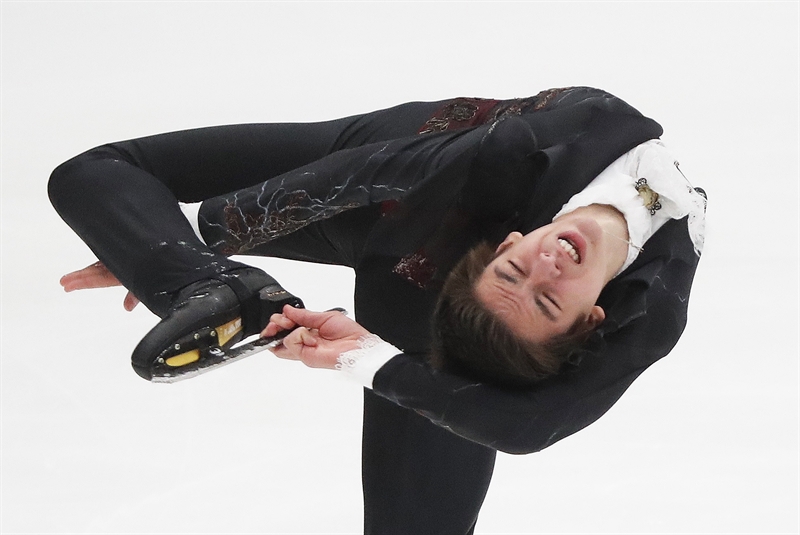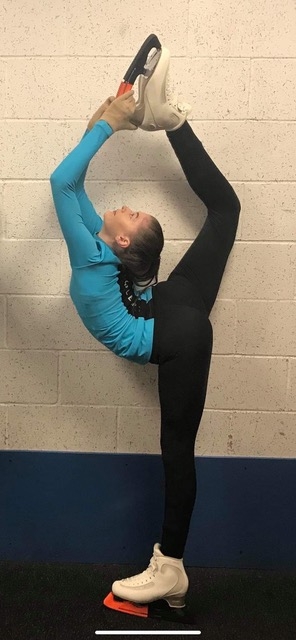You are viewing 1 of your 1 free articles
Back pain in ice skaters: How to prevent the downhill spiral

The various forms of figure skating, singles, pairs, dance, and synchronized, all have technically challenging elements that require strength, flexibility, artistic flare, and grace. It takes significant amounts of training and practice to perfect this unique sport. Ice skaters can spend 15 to 30 hours training on the ice with a further five to 15 hours off the ice per week(1). Injury rates are consequentially high, with almost 80% of skaters experiencing an injury in their careers(1). Skating related injuries are equally split between overuse and acute injuries(1). Low back pain accounts for around 15% of the complaints, which is no surprise considering the force placed through the spine and pelvis while skating(2).
Risk factors
Ice skaters wear stiff, rigid boots that reduce ankle dorsiflexion to protect the ankle joint from the ground reaction forces experienced when landing from a jump. This limited joint movement alters the load transmission through the lower limb and the biomechanics of the kinetic chain(3).Skaters experience ground reaction forces of eight to 10 times their body weight when they jump and land on a single limp. A skater performs approximately 50 to 100 jumps in one training session, creating an excessiveand repetitive load transfer through one leg to the pelvis and lumbar spine. This atypical loading pattern can create an asymmetry in muscle balance and lead to an overuse injury.
Extreme ranges of spinal movement are required to display the technical aspects of spins, jumps, and elements, with excessive flexion, extension, and torsion movements. These extreme movements are not only aesthetically pleasing, but the tight figure fosters increased momentum and speed, generating more revolutions, and thus higher marks. The skater then exits their jump or spin rapidly and continues their performance, moving quickly in and out of these extreme ranges.
Figure 1: Technical element “catch foot”

Note the degree of spinal extension required from the figure skater to execute this technical element.
Types of back pain injuries
Repeated flexion, extension, or torsion of the spine places physical stress on the vertebrae, discs, and surrounding structures. Forced movement into extreme ranges of motion can cause several pathologies. If there is any suspicion of these diagnoses, refer to a medical professional for further investigations and management.Spondylolysis: A defect or stress fracture in the pars interarticularis (a region of the vertebral arch). These can account for nearly 50% of back pain injuries in young athletes involved in repetitive flexion and spinal extension movements(4).
Spondylolisthesis: Where one vertebrae slips forwards out of its normal position. These are usually managed conservatively unless the slip is more than 50%.
Sacroiliac joint (SIJ) pain: Pain can radiate directly from the SIJ. This pain may occur from the increased load through one side e.g., repetitive single leg jumps and landings, or the excessive or reduced motion at the SIJ itself.
Disc herniation: The disc center (nucleus pulposus) herniates into the annulus fibrosis (the surrounding structure) and causes severe pain and often restricted movement. Herniations are uncommon in figure skaters as their flexibility and conditioning make them less susceptible. Where herniation does occur, approximately90% resolve with conservative treatment(5).
Rehabilitation focus
Back pain rehabilitation and prevention programs should focus on core stability and strength to support the lumbopelvic region (see table 1). Trunk strength is paramount to supporting the upright posture and axis of rotation and offers protection in extreme positions while counteracting the centrifugal forces(6). Core strength consisting of transversus abdominis and multifidus coordination is preferential over erector spinae and iliopsoas (hip flexor) function, Deep core strength provides intrinsic support for the spine compared to these more superficial muscles. Incorporate gluteal strengthening as they contribute to almost every skating skill and may absorb ground reaction forces, thus decreasing stress through the spine and reducing the risk of injury to the lower back.Figure 2: Forward stroking

The gluteal muscles are the driving force to create power across the ice in the stroking maneuver, while the skater needs a strong upright trunk to execute the movement well.
After core and glute strength, rehabilitation should target balance, proprioception, and kinetic chain development. Skaters perform on a four to five millimeter blade edge and require excellent stability while repeatedly extending their trunk outside of their base of support. Posterior chain strength is necessary to coordinate the muscles and provide balance to counteract the flexion based activities.
Incorporate sport-specific training by including plyometrics activities to train for explosive take-offs, landings, and powerful strokes across the ice. Practicing jumping and landing maneuvers trains muscles to absorb the ground reaction forces rather than transfer them to the spine.
Regular stretching is required to improve flexibility for both technical and aesthetic points. Having the needed flexibility minimizes strain to the spine. In particular, stretches should enhance hip flexor mobility, hamstring length, and spinal extension.
| Area | Exercises | Skating skill relevance |
|---|---|---|
| Core | Prone Swimmers | Coordination of upper & lower body during choreography. |
| Dead bug | ||
| Glute strength | Single leg bridge | Forward stroking/pushing. |
| Sit spins. | ||
| Single leg deadlift | Single leg footwork. | |
| Spirals. Camel spins. | ||
| Monster walks- all directions | Forward & backward stroking power. Stability in single-leg choreography. | |
| Balance & kinetic chain | Skater lunge | Stroking. Landing positions. |
| Camel spins. Spiral variations. | ||
| Spiral star excursions | ||
| Plyometrics | Lateral push-off jumps | Stroking power. |
| Jump squats | All variations of jumps, take-offs, and their landings. | |
| Jump scissors (7) | ||
| Stretches | Hip flexors | All stretches apply to all aspects of skating skills |
| Hamstrings | ||
| Gluteal figure of 4 | ||
| Spine extension | Layback and catch foot spins, spirals. |
*Videos of a few of the suggested exercises are available in the links above
Periodization
With a high volume training schedule, regular skills testing that requires competition level performance, and a year-round competitive calendar, there is no singular peak in the skating cycle for periodization design. Periodization will have to accommodate weekly changes based on the skater’s current workload. This is an essential factor in reducing overload and consequentially decreasing the risk of injury.During busier periods, rehabilitation should focus on core and balance training, and during quieter phases, the focus should be on gluteal strength and plyometric power exercises(7). High sets with low repetitions are suggested to minimize overload on the body while the skater maintains their on ice-training scheduled concurrently.
Summary
- Figure skating is unique in its demands for strength and power, combined with flexibility and grace. To perfect all aspects of the sport, skaters participate in rigorous training schedules. This demanding regimen results in a high risk of injury from overuse training. Because skaters must maintain near-peak performance levels throughout the year, they experience few opportunities for periodized training.
- Factors that contribute to low back injuries include the rigid skating boots, repetitions of single-leg jump execution and landing, leg muscle asymmetries, and extreme ranges of motion.
- Rehabilitation should take a progressive approach. Firstly focus on core stability and trunk strength, followed by gluteal strength, balance and proprioception, plyometrics, and finally, flexibility restoration.
- Prevention programs should be incorporated into the training schedule year-round but modified to reflect training load. Emphasize core work during heavy training times and glutes and plyometrics during periods of low training load.
References
- Clin Sports Med. 2000; 19: 369-380.
- Int J Sports Med. 2006; 27; 493-499.
- Clin Sports Med. 2012; 31: 397-408.
- Arch Pediatr Adolesc Med. 1995; 149: 15-18.
- Orthopaedics. 2009; 212-222. DOI: 10.1177/19417381094334212.
- Clin Sports Med. 2000; 14: 215-224.
- NSCA. 2017; 39(3): 58-65.
Related Files
Newsletter Sign Up
Subscriber Testimonials
Dr. Alexandra Fandetti-Robin, Back & Body Chiropractic
Elspeth Cowell MSCh DpodM SRCh HCPC reg
William Hunter, Nuffield Health
Newsletter Sign Up
Coaches Testimonials
Dr. Alexandra Fandetti-Robin, Back & Body Chiropractic
Elspeth Cowell MSCh DpodM SRCh HCPC reg
William Hunter, Nuffield Health
Be at the leading edge of sports injury management
Our international team of qualified experts (see above) spend hours poring over scores of technical journals and medical papers that even the most interested professionals don't have time to read.
For 17 years, we've helped hard-working physiotherapists and sports professionals like you, overwhelmed by the vast amount of new research, bring science to their treatment. Sports Injury Bulletin is the ideal resource for practitioners too busy to cull through all the monthly journals to find meaningful and applicable studies.
*includes 3 coaching manuals
Get Inspired
All the latest techniques and approaches
Sports Injury Bulletin brings together a worldwide panel of experts – including physiotherapists, doctors, researchers and sports scientists. Together we deliver everything you need to help your clients avoid – or recover as quickly as possible from – injuries.
We strip away the scientific jargon and deliver you easy-to-follow training exercises, nutrition tips, psychological strategies and recovery programmes and exercises in plain English.










